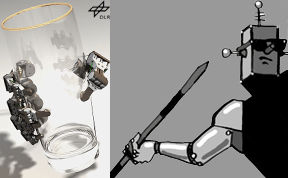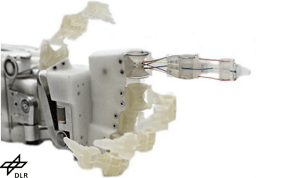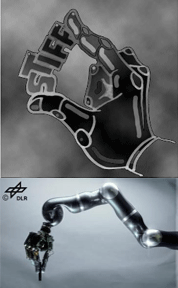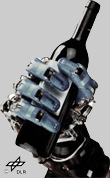

|
Welcome to Jürgen Schmidhuber's subsite associated with the STIFF project on enhancing biomorphic agility of robot arms and hands through variable stiffness & elasticity. The project is funded by the 7th framework programme of the European Union (STREP grant agreement No: 231576). Official STIFF Project Homepage Secure Internal STIFF Homepage (login required) Institutional Partners Deutsches Zentrum für Luft- und Raumfahrt e.V. (DLR), Germany Technische Universiteit Delft, Netherlands IDSIA, Switzerland University of Edinburgh, United Kingdom
Université Paris Descartes - CNRS,
France
Collaborators (to be extended)
DLR: Delft: IDSIA: Edinburgh: CNRS:
This site is still under construction; it will be
updated as the project is moving forward.
Fibonacci web design by
J. Schmidhuber,
2009. STIFF logo (upper left corner) by Ian Saunders; other cartoons by J. Schmidhuber.
|

|
How can stiffness & elasticity enhance performance of human and robotic arms? Our targeted modelling studies will combine detailed biophysical models and machine learning to achieve optimal control of an embodied, highdimensional, variable- impedance robotic system. . |
|
Many industrial robots are much stronger than humans, but also very inflexible. For example, humans can throw objects much further and catch them much more gracefully, temporarily storing energy in elastic tendons and muscles. Such flexible actuators, however, require more sophisticated control algorithms than those used by traditional robots. The goal of the STIFF consortium is to equip a highly biomimetic robot hand-arm system with the agility, robustness and versatility that are the hallmarks of the human motor system, by understanding and mimicking the variable stiffness paradigms that are so effectively employed by the human central nervous system. A key component of our study will be the anatomically accurate musculoskeletal modelling of the human arm and hand. The project will develop novel methodologies to comprehend how the human arm can adapt its impedance, e.g., by changing the co-contraction level or by adapting reflex gains. The impedances of arm and hand will be investigated using powerful robot manipulators capable of imposing force perturbations. While stiffness & elasticity are currently exploited in the context of artificial laboratory tasks, we will investigate stiffness-dependent behaviour in natural tasks such as throwing a ball or inserting a peg in a hole. Existing closed-loop system identification techniques will be extended by non-linear time-variant techniques to identify the behaviour during reaching and grasping tasks. Grasp force modulation and hand muscle activity correlations will be acquired through machine learning techniques and then transferred to the robotic system. Finally, optimization techniques gleaned and validated on the detailed biophysical model will be transferred to the variable impedance actuation of the novel biomorphic robot.
|


|
Recent events 26 Oct 2009 Consortium meets in Edinburgh 22-23 June Biomechanics Course at DLR by F.v.d.Helm 19 May 2009 Human Stiffness Workshop, Paris . |
|
Selected publications relevant for this project (this is still very incomplete - much more to come): 1. S. Yi, D. Wierstra, T. Schaul, J. Schmidhuber. Efficient Natural Evolution Strategies. Genetic and Evolutionary Computation Conference (GECCO-09), Montreal, 2009. PDF. Best paper award. 2. F. Gomez, J. Schmidhuber, R. Miikkulainen. Accelerated Neural Evolution through Cooperatively Coevolved Synapses. Journal of Machine Learning Research (JMLR), 9:937-965, 2008. PDF. 3. H. Mayer, F. Gomez, D. Wierstra, I. Nagy, A. Knoll, and J. Schmidhuber. A System for Robotic Heart Surgery that Learns to Tie Knots Using Recurrent Neural Networks. Advanced Robotics, 22/13-14, p. 1521-1537, 2008. 4. A. Haith, C. Jackson, C. Miall and S. Vijayakumar. Unifying the Sensory and Motor Components of Sensorimotor Adaptation, Proc. Advances in Neural Information Processing Systems (NIPS '08), Vancouver, Canada (2008). 5. D. Mitrovic, S. Klanke, S. Vijayakumar. Adaptive Optimal Control for Redundantly Actuated Arms, Asada et. al (eds.) Proc. Tenth International Conference on the Simulation of Adaptive Behavior (SAB '08), Springer-Verlag LNAI 5040, pp. 93-102, Osaka, Japan (2008). 6. M. Grebenstein, P. van der Smagt, Antagonism for a highly anthropomorphic hand-arm system, Advanced Robotics 22 (2008), no. 1, 39-55. PDF. |

